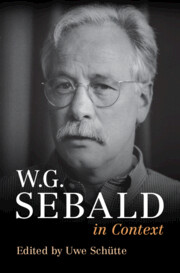Book contents
- W.G. Sebald in Context
- W.G. Sebald in Context
- Copyright page
- Dedication
- Contents
- Illustrations
- Notes on Contributors
- Preface
- Acknowledgements
- Note on Text
- Chronology
- Abbreviations
- Works by W.G. Sebald
- Part I Biographical Aspects
- Part II The Literary Works
- Part III Themes and Influences
- Chapter 17 Critical Writings
- Chapter 18 Minor Writing
- Chapter 19 Franz Kafka
- Chapter 20 Literary Predecessors
- Chapter 21 Walter Benjamin
- Chapter 22 Philosophical Models
- Chapter 23 History
- Chapter 24 Polemics
- Chapter 25 Holocaust
- Chapter 26 Photography
- Chapter 27 Paintings and Ekphrasis
- Chapter 28 Media Theory
- Chapter 29 Travel Writing
- Chapter 30 Ecocriticism and Animal Studies
- Part IV Reception and Legacy
- Further Reading
- Index
Chapter 27 - Paintings and Ekphrasis
from Part III - Themes and Influences
Published online by Cambridge University Press: 24 August 2023
- W.G. Sebald in Context
- W.G. Sebald in Context
- Copyright page
- Dedication
- Contents
- Illustrations
- Notes on Contributors
- Preface
- Acknowledgements
- Note on Text
- Chronology
- Abbreviations
- Works by W.G. Sebald
- Part I Biographical Aspects
- Part II The Literary Works
- Part III Themes and Influences
- Chapter 17 Critical Writings
- Chapter 18 Minor Writing
- Chapter 19 Franz Kafka
- Chapter 20 Literary Predecessors
- Chapter 21 Walter Benjamin
- Chapter 22 Philosophical Models
- Chapter 23 History
- Chapter 24 Polemics
- Chapter 25 Holocaust
- Chapter 26 Photography
- Chapter 27 Paintings and Ekphrasis
- Chapter 28 Media Theory
- Chapter 29 Travel Writing
- Chapter 30 Ecocriticism and Animal Studies
- Part IV Reception and Legacy
- Further Reading
- Index
Summary
This essay provides an associatively structured overview of the wide field of painting and ekphrasis in Sebald’s work. Starting with Sebald’s collaborations with his friend and artist Jan Peter Tripp, the essay moves to his use of Rembrandt’s The Anatomy Lesson of Dr Nicolaes Tulp (1632) in The Rings of Saturn. Then the essay then explores the role of battle paintings in Sebald’s writings, especially their use to discuss issues of representation of historical events. In the next step, figurations of melancholy in Sebald are discussed on the basis of Dürer’s engraving Melencolia along with the theme of pulverization relating to the painter Ferber in The Emigrants. The conclusion compares Sebald’s poetics to the epistemology of knowledge inaugurated by Aby Warburg’s Bilderatlas Mnemosyne.
Keywords
- Type
- Chapter
- Information
- W. G. Sebald in Context , pp. 242 - 248Publisher: Cambridge University PressPrint publication year: 2023

